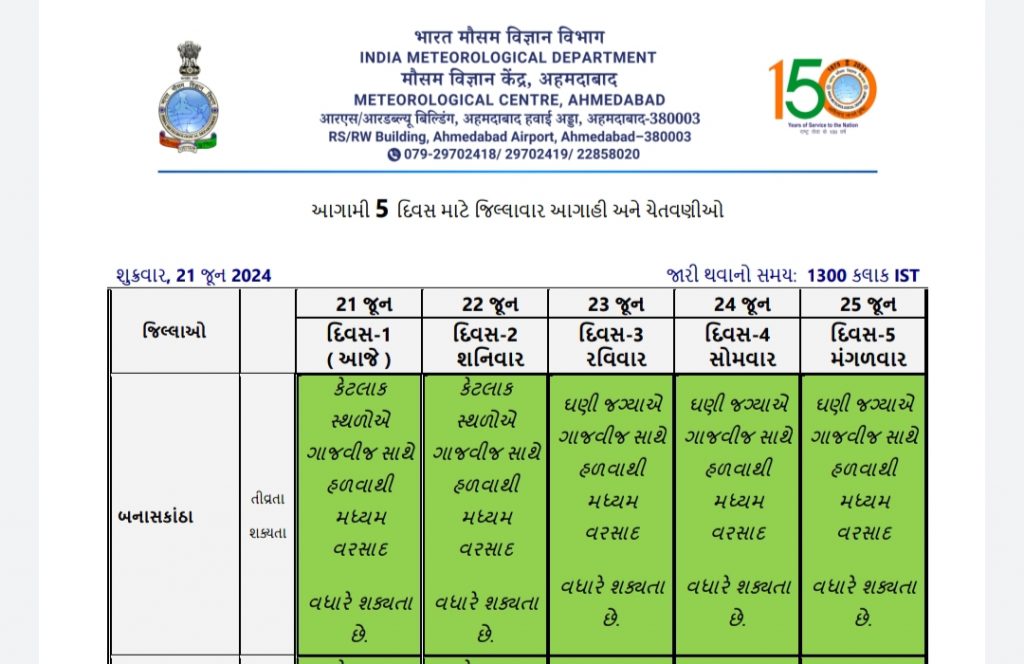
Torrential rain is a meteorological phenomenon characterized by intense and heavy rainfall over a short period. This natural occurrence can have profound effects on the environment, infrastructure, and communities. In this article, we delve into the causes of torrential rain, its impacts, and essential safety measures.
Causes of Torrential Rain
Torrential rain occurs due to several meteorological factors converging to create conditions conducive to heavy precipitation:
વરસાદ ની આગાહિ અંગે ડીટેઇલ ન્યુઝ
વરસાદ અંગે હવામાન વિભાગની આગાહિ PDF
- Weather Systems: Torrential rain often accompanies strong weather systems such as tropical cyclones, thunderstorms, or monsoons. These systems bring moisture-laden air masses that release large amounts of rain in a short time.
- Orographic Effects: When moist air is forced to rise over mountains or hills, it cools and condenses, leading to enhanced rainfall on the windward side (upwind) of the terrain. This process, known as orographic lifting, can contribute to torrential downpours.
- Atmospheric Instability: Rapidly rising warm air and the presence of cold air aloft can create unstable atmospheric conditions, fostering the development of intense convective storms that produce torrential rain.
Impacts of Torrential Rain
The consequences of torrential rain can be severe and wide-ranging:
- Flooding: One of the most immediate impacts of torrential rain is flash flooding. The sudden influx of water overwhelms drainage systems, leading to inundation of streets, homes, and businesses. Flash floods can occur within minutes of intense rainfall, catching people unaware and causing dangerous conditions.
- Infrastructure Damage: Torrential rain can damage infrastructure such as roads, bridges, and buildings. Floodwaters can erode soil around foundations, leading to structural instability and potential collapse. Infrastructure damage often disrupts transportation networks and utilities, affecting daily life and economic activities.
- Environmental Consequences: Heavy rainfall can result in soil erosion, sediment runoff into water bodies, and disruption of ecosystems. Excessive runoff can lead to water pollution as it carries contaminants from urban areas or agricultural fields into rivers and lakes.
- Human Safety Concerns: Torrential rain poses risks to human safety, including drowning, injuries from debris carried by floodwaters, and accidents due to impaired visibility and slippery road conditions. Vulnerable populations, such as those living in low-lying areas or near water bodies, are particularly at risk.
Safety Measures During Torrential Rain
To mitigate the risks associated with torrential rain, it is essential to take proactive safety measures:
- Stay Informed: Monitor weather forecasts and alerts from reliable sources. Pay attention to warnings issued by meteorological agencies and local authorities.
- Prepare an Emergency Kit: Have an emergency kit ready with essential supplies including non-perishable food, water, medications, and first-aid items. Include items such as flashlights, batteries, and a portable radio.
- Create an Evacuation Plan: Know your evacuation routes and have a plan in place for relocating to higher ground or designated shelters if necessary. Practice the plan with your family members or household.
- Protect Property: Clear gutters and drains regularly to ensure proper water flow. Consider installing flood barriers or sandbags around vulnerable areas of your property to divert water away from buildings.
- Avoid Flooded Areas: Never attempt to walk, swim, or drive through flooded areas, as water depth and currents can be deceptive and dangerous. Turn around and find an alternate route.
Conclusion
Torrential rain is a powerful natural phenomenon that demands respect and preparedness. By understanding its causes, recognizing its impacts, and implementing effective safety measures, individuals and communities can reduce the risks associated with intense rainfall events. Stay informed, stay safe, and be proactive in protecting yourself and your surroundings during periods of torrential rain.
By following these guidelines, you can better prepare for and respond to torrential rain events, ensuring the safety and well-being of yourself and those around you.